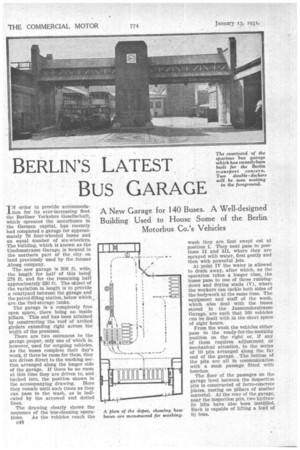BERLIN'S LATEST BUS GARAGE
Page 70

Page 71

If you've noticed an error in this article please click here to report it so we can fix it.
IN order to provide accommodation for its ever-increasing fleet the Berliner Verkehrs Gesellschaft, which operates the motorbuses in the German capital, has recently had completed a garage for approximately 70 four-wheeled buses and an equal number of six-wheelers. The building, which is known as the Usedomstrasse Garage, is located in the northern part of the , city on land previously used by the former Aboag company.
The, new garage is 206 ft. wide, the length for half of this being 278 ft. and for the remaining half approximately 330 ft. The object of the variation in length is to provide a courtyard between the garage and the petrol-filling station, below which. are the 'fuel-storage tanks.
The garage is a completely free open space, there being no inside pillars. This end has been attained by constructing the roof of arched girders extending right across the width of the premises.
There are two entrances to the garage proper, only one of which is, however, used for outgoing vehicles. As the buses complete their day's work, if there be room for them, they are driven direct to the washing section arranged along the longer side of the garage. If there be no room at this time they are driven to, and backed into, the position shown in " the accompanying drawing. Here they remain until such times as they can pass to the wash, as is indicated by the arrowed and dotted The drawing clearly shows the sequence of the bus-cleaning opera tions. As the vehicles reach the c4S wash they are first swept out at position I. They next pass to positions II and III, where they are sprayed with water, first gently and then with powerful jets.
At point IV the water is allowed to drain away, after which, as the operation takes a longer time, the buses pass to one of three rubbingdown and drying stalls (V), where the workers can tackle both sides of the bodywork at the same time. The equipment and staff of the wash, which also deal with the buses stored in the Jasmunderstrasse Garage, are such that 160 vehicles can be dealt with in the short space of eight hours. From the wash the vehicles either pass to the ready-for-the-morning position on the right or; if any of them requires adjustment or mechanical attention, to the series of 10pits arranged along the far end of the garage. The bottom of the pits are all in communication with a sunk passage fitted with benches.
The floor of the passages on the garage level between the inspection pits is constructed of ferro-concrete plates, resting on pillars of similar material. At the rear of the garage, near the inspection pits, two hydraulic lifts have also been installed. Each is capable of lifting a load of tons. These hoists are of the singlepillar type, with 'a platform of a length 'sufficient to enable one of the latest six-wheeled double-deck buses to be lifted. When not in use the lifts are covered by removable planks which lie level with the garage floor.
At the front end of the garage is a small two-storey building, the ground 'floor. of which is devoted to a foreman's room, a battery-charging and maintenance department, and wheel and tyre stores. On the first floor is a driver's instruction room, a paint and carpenters' shop, and a glazing shop and glass store.
In the basement of the building are the transformer and switchcontrol rooms. On the garage level, on the two sides of the rear end of the building, are other workshops and stores, the tool and spare parts department ibeing located on one side, and smithy and repair shops on the other.
Further works departments, lavatories, etc., are provided on the first floor, whilst in the basement, which extends below a yard at the rear, are the heating apparatus, coal stores and sprinkler-operating firefighting installation. The engine-oil store is also located in the basement, at the rear of the building.
The installation comprises four steam-heated vertical tanks, each with a capacity of 220 gallons. The shop is provided with chain-operated pulley blocks for lifting the casks of oil as they come into a gallery above the tanks, so that the containers can be emptied by gravity. The tanks are connected with delivery pipes leading to suitable points in the garage, the oil delivery being effected by compressed air.
The entrance to the new garage from the street is by a passage at right angles to it, about 0 yds. long, leading out of the Usedomstrasse, there being two gates, one for incoming and one for outgoing buses. At the garage end of the passage is the bus petrol-filling station, which has the Berlin concern's usual practice of an overhead bridge with supervisor's office in the centre. The installation is such that four buses can be filled at a time, the fuel being fed into the tanks by means of electrically driven pumps, capable of delivering 44 gallons per minute.
Although normally all vehicles pass to or from the old -and new
garage by the one gate, two emergency exits are provided at the rear.
We are indebted to Herr G. Quarg, the director of the Berlin company, for the accompanying illustrations of the new garage.












































































































